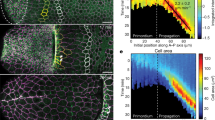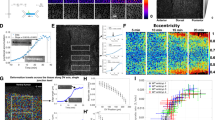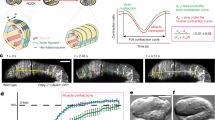Abstract
Tissue morphogenesis is orchestrated by cell shape changes. Forces required to power these changes are generated by non-muscle myosin II (MyoII) motor proteins pulling filamentous actin (F-actin). Actomyosin networks undergo cycles of assembly and disassembly (pulses)1,2 to cause cell deformations alternating with steps of stabilization to result in irreversible shape changes3,4,5,6. Although this ratchet-like behaviour operates in a variety of contexts, the underlying mechanisms remain unclear. Here we investigate the role of MyoII regulation through the conserved Rho1–Rok pathway7 during Drosophila melanogaster germband extension. This morphogenetic process is powered by cell intercalation, which involves the shrinkage of junctions in the dorsal–ventral axis (vertical junctions) followed by junction extension in the anterior–posterior axis8. While polarized flows of medial–apical MyoII pulses deform vertical junctions, MyoII enrichment on these junctions (planar polarity) stabilizes them6. We identify two critical properties of MyoII dynamics that underlie stability and pulsatility: exchange kinetics governed by phosphorylation–dephosphorylation cycles of the MyoII regulatory light chain; and advection due to contraction of the motors on F-actin networks. Spatial control over MyoII exchange kinetics establishes two stable regimes of high and low dissociation rates, resulting in MyoII planar polarity. Pulsatility emerges at intermediate dissociation rates, enabling convergent advection of MyoII and its upstream regulators Rho1 GTP, Rok and MyoII phosphatase. Notably, pulsatility is not an outcome of an upstream Rho1 pacemaker. Rather, it is a self-organized system that involves positive and negative biomechanical feedback between MyoII advection and dissociation rates.
This is a preview of subscription content, access via your institution
Access options
Subscribe to this journal
Receive 51 print issues and online access
$199.00 per year
only $3.90 per issue
Buy this article
- Purchase on Springer Link
- Instant access to full article PDF
Prices may be subject to local taxes which are calculated during checkout




Similar content being viewed by others
References
Munro, E., Nance, J. & Priess, J. R. Cortical flows powered by asymmetrical contraction transport PAR proteins to establish and maintain anterior-posterior polarity in the early C. elegans embryo. Dev. Cell 7, 413–424 (2004)
Kim, H. Y. & Davidson, L. A. Punctuated actin contractions during convergent extension and their permissive regulation by the non-canonical Wnt-signaling pathway. J. Cell Sci. 124, 635–646 (2011)
Martin, A. C., Kaschube, M. & Wieschaus, E. F. Pulsed contractions of an actin-myosin network drive apical constriction. Nature 457, 495–499 (2009)
Solon, J., Kaya-Copur, A., Colombelli, J. & Brunner, D. Pulsed forces timed by a ratchet-like mechanism drive directed tissue movement during dorsal closure. Cell 137, 1331–1342 (2009)
He, L., Wang, X., Tang, H. L. & Montell, D. J. Tissue elongation requires oscillating contractions of a basal actomyosin network. Nature Cell Biol. 12, 1133–1142 (2010)
Rauzi, M., Lenne, P. F. & Lecuit, T. Planar polarized actomyosin contractile flows control epithelial junction remodelling. Nature 468, 1110–1114 (2010)
Kaibuchi, K., Kuroda, S. & Amano, M. Regulation of the cytoskeleton and cell adhesion by the Rho family GTPases in mammalian cells. Annu. Rev. Biochem. 68, 459–486 (1999)
Bertet, C., Sulak, L. & Lecuit, T. Myosin-dependent junction remodelling controls planar cell intercalation and axis elongation. Nature 429, 667–671 (2004)
Levayer, R. & Lecuit, T. Biomechanical regulation of contractility: spatial control and dynamics. Trends Cell Biol. 22, 61–81 (2012)
Niederman, R. & Pollard, T. D. Human platelet myosin. II. In vitro assembly and structure of myosin filaments. J. Cell Biol. 67, 72–92 (1975)
Lee, A. & Treisman, J. E. Excessive Myosin activity in mbs mutants causes photoreceptor movement out of the Drosophila eye disc epithelium. Mol. Biol. Cell 15, 3285–3295 (2004)
Kimura, K. et al. Regulation of myosin phosphatase by Rho and Rho-associated kinase (Rho-kinase). Science 273, 245–248 (1996)
Jordan, P. & Karess, R. Myosin light chain-activating phosphorylation sites are required for oogenesis in Drosophila. J. Cell Biol. 139, 1805–1819 (1997)
Dawes-Hoang, R. E. et al. folded gastrulation, cell shape change and the control of myosin localization. Development 132, 4165–4178 (2005)
Vasquez, C. G., Tworoger, M. & Martin, A. C. Dynamic myosin phosphorylation regulates contractile pulses and tissue integrity during epithelial morphogenesis. J. Cell Biol. 206, 435–450 (2014)
Kasza, K. E., Farrell, D. L. & Zallen, J. A. Spatiotemporal control of epithelial remodeling by regulated myosin phosphorylation. Proc. Natl Acad. Sci. USA 111, 11732–11737 (2014)
Vereshchagina, N. et al. The essential role of PP1beta in Drosophila is to regulate nonmuscle myosin. Mol. Biol. Cell 15, 4395–4405 (2004)
Watanabe, T., Hosoya, H. & Yonemura, S. Regulation of myosin II dynamics by phosphorylation and dephosphorylation of its light chain in epithelial cells. Mol. Biol. Cell 18, 605–616 (2007)
Fernandez-Gonzalez, R., Simoes Sde, M., Roper, J. C., Eaton, S. & Zallen, J. A. Myosin II dynamics are regulated by tension in intercalating cells. Dev. Cell 17, 736–743 (2009)
Rauzi, M., Verant, P., Lecuit, T. & Lenne, P. F. Nature and anisotropy of cortical forces orienting Drosophila tissue morphogenesis. Nature Cell Biol. 10, 1401–1410 (2008)
Sen, A., Nagy-Zsver-Vadas, Z. & Krahn, M. P. Drosophila PATJ supports adherens junction stability by modulating Myosin light chain activity. J. Cell Biol. 199, 685–698 (2012)
Bardet, P. L. et al. PTEN controls junction lengthening and stability during cell rearrangement in epithelial tissue. Dev. Cell 25, 534–546 (2013)
Mason, F. M., Tworoger, M. & Martin, A. C. Apical domain polarization localizes actin-myosin activity to drive ratchet-like apical constriction. Nature Cell Biol. 15, 926–936 (2013)
Simões Sde, M. et al. Rho-kinase directs Bazooka/Par-3 planar polarity during Drosophila axis elongation. Dev. Cell 19, 377–388 (2010)
Nemoto, Y., Namba, T., Kozaki, S. & Narumiya, S. Clostridium botulinum C3 ADP-ribosyltransferase gene. Cloning, sequencing, and expression of a functional protein in Escherichia coli. J. Biol. Chem. 266, 19312–19319 (1991)
Piekny, A. J. & Glotzer, M. Anillin is a scaffold protein that links RhoA, actin, and myosin during cytokinesis. Curr. Biol. 18, 30–36 (2008)
Levayer, R. & Lecuit, T. Oscillation and Polarity of E-Cadherin Asymmetries Control Actomyosin Flow Patterns during Morphogenesis. Dev. Cell 26, 162–175 (2013)
Simões Sde, M., Mainieri, A. & Zallen, J. A. Rho GTPase and Shroom direct planar polarized actomyosin contractility during convergent extension. J. Cell Biol. 204, 575–589 (2014)
Lewis, J. Autoinhibition with transcriptional delay: a simple mechanism for the zebrafish somitogenesis oscillator. Curr. Biol. 13, 1398–1408 (2003)
Karess, R. E. et al. The regulatory light chain of nonmuscle myosin is encoded by spaghetti-squash, a gene required for cytokinesis in Drosophila. Cell 65, 1177–1189 (1991)
Cavey, M. & Lecuit, T. Imaging cellular and molecular dynamics in live embryos using fluorescent proteins. Methods Mol. Biol. 420, 219–238 (2008)
Acknowledgements
We thank M. Rao for useful discussions, and the Lecuit and Lenne groups and the Labex INFORM (ANR-11-LABX-0054) for support and discussions. We are grateful to M. Krahn, A. Martin, V. Mirouse, J. Treisman and J. Zallen for the gift of flies. This work was supported by the ANR Archiplast and the ERC (Biomecamorph #323027) and HFSP (T.L. and E.M.). A.M. was supported by Ministère de l'Éducation nationale and the Association pour la Recherche contre le Cancer (ARC). We acknowledge the France-BioImaging/PICsL infrastructure (ANR-10-INSB-04-01).
Author information
Authors and Affiliations
Contributions
This project originated from discussions between T.L. and E.M., based on a computational model developed by E.M. A.M. and T.L. planned the project, discussed the data with input from E.M., and wrote the paper. A.M. did all the experiments and analysis. J.-M.P. made the fly constructs and helped with molecular biology.
Corresponding author
Ethics declarations
Competing interests
The authors declare no competing financial interests.
Extended data figures and tables
Extended Data Figure 1 RNAi specifically downregulates MyoII phosphatase resulting in cellular and tissue-level defects.
a, Gene expression data of Mypt-75d measured from quantitative PCR in water- and dsRNA-injected embryos using two different Taqman probes. P values calculated with unpaired t-test. b, Distribution of percentage of GBE in water and Mypt dsRNA-injected embryos. c, Box plot of time taken for junction shrinkage in water and Mypt dsRNA-injected embryos. d, MyoII distribution in control (left) and MBS shRNA-expressing embryo (right). e, Average planar polarity of MyoII in these conditions. P values calculated with Mann–Whitney U-test. Scale bar, 5 μm.
Extended Data Figure 2 RLC phospho-cycling determines quantitative levels of MyoII at cell junctions.
a, Distribution of MyoII in embryos co-expressing wild-type (WT) RLC–GFP with wild-type RLC–mCherry (top) and phosphomimetic RLC–GFP with wild-type RLC–mCherry (bottom) injected with water (left) or Y27632 (right). b, Mean intensity of MyoII in mCherry (top) and GFP (bottom) channels in these conditions. P values calculated with Student’s t-test. c, Distribution of MyoII in control embryos or in embryos expressing constitutively active MBS (CA-MBS). d, Average junctional intensity of MyoII in these conditions. P values calculated with Student’s t-test. e, Average intensities of MyoII on transverse junctions in various conditions. P values calculated with Mann–Whitney U-test. Scale bar, 5 μm.
Extended Data Figure 3 Proportions and cycling of phosphorylated RLC regulates MyoII turnover and mechanical tension.
a, b, Mean fluorescence recovery time traces (normalized as described in methods) of RLC–GFP from vertical (red) and transverse junctions (blue) in wild-type (a) and Mypt-75d RNAi (b) embryos. The dotted lines are fits derived from the equation described in the methods. c, Table shows the goodness of fit (R2) and the respective mobile fraction from fitted curves in a and b. d, Plot shows the mobile fraction of RLC in different conditions. Values from each junction (open circles) and the average from all junctions (open rectangle) are shown. e, Cartoon showing scission of junctions and their elastic recoil in response f, Vertical and transverse junctions before (0 s) and after (5 s) laser ablation in different conditions. g, Recoil velocities of vertical and transverse junctions in different conditions. Values from each junction (open circles) and the average from all junctions (open rectangle) are shown. P values calculated with Mann–Whitney U-test. Scale bar, 1 μm.
Extended Data Figure 4 Wild-type Rok is planar polarized and pulsatile during GBE.
a, Average planar polarity of MBS and MyoII. b, Distribution of wild-type Rok (RokWT)–GFP without (left) and with (right) RLC–mCherry (top). Scale bar, 5 μm. c, Average enrichment of RokWT–GFP relative to MyoII enrichment at junctions categorized by their angles (bottom). d, Time snapshots of RokWT–GFP embryos injected with water (top) or 10 mM Y27632 (bottom). Scale bar, 1 μm.
Extended Data Figure 5 Rho1 GTP is required for MyoII activation.
a, Representative images of AniRBD–GFP (left) and RLC–mCherry (right) in water (top) and C3 exoenzyme (bottom) injected embryos. Scale bar, 5 μm. b, AniRBD–GFP and RLC–mCherry mean junctional intensities in water and C3 exoenzyme injected embryos. P values calculated by Student's t-test. c, Mean medial intensity time trace of AniRBD–GFP (left) and RLC–mCherry (right) in C3 exoenzyme injected embryos compared to a representative water injected embryo. Error bars represent s.d. d, Time snapshots showing medial pool of RLC–GFP in control and embryo expressing constitutively active Rho (RhoV14). Scale bar, 1 μm. e, Mean medial intensity time traces of RLC–GFP in different conditions and stages (Error bars: Standard deviation) f, Average pulse amplitudes of RLC–mCherry and kinase-dead Rok (RokKD)–GFP in control and RhoV14-expressing embryos g, h, Average duration and frequency of MyoII pulses in control and RhoV14-expressing embryos. P values calculated by Mann–Whitney U test.
Extended Data Figure 6 Non-linear MyoII accumulation from stochastic Rho1 activation.
a, b, Mean medial intensity time traces of RokKD–GFP (a) and AniRBD–GFP (b) in various conditions. Error bars indicated s.d. c, Average rate of change (first derivative) of AniRBD–GFP, RokKD–GFP and RLC–GFP medial intensities during pulse assembly. d, Temporal cross-correlation analysis of medial intensity time traces of RLC–mCherry with AniRBD–GFP during early GBE (stage 5a) and GBE (stage 7). e, Distribution of centres of masses of MyoII medial intensity at the time of pulse coalescence.
Extended Data Figure 7 MyoII regulatory pathway components are advected.
a, Time snapshot from medial pool of embryos expressing either RokKD–Venus (top) or RokKDΔRBD–Venus (bottom). b, Mean pulse amplitudes of RokKD–Venus and RokKDΔRBD–Venus. c, Pairwise correlation of RokKD– GFP, RokKDΔRBD–Venus and AniRBD–GFP pulse amplitudes with the respective RLC–mCherry pulse amplitudes d, Time snapshot from medial pool of embryos expressing either cytosolic GFP (top) or α-catenin–YFP (bottom). e, Mean medial intensity time traces of RLC–mCherry, cytosolic GFP and α-catenin–YFP during GBE. Scale bar, 1 μm.
Extended Data Figure 8 RLC dephosphorylation is required for pulse disassembly.
a–c, Mean MyoII pulse duration (a), amplitude (b) and frequency (c) in various conditions. P values calculated with Mann–Whitney U-test. d, Average advection velocity of medial MyoII and RokKD in wild-type and mypt dsRNA-injected embryos. P values calculated with Mann–Whitney U-test. e, Average divergence values from many cells of embryos expressing wild-type RLC–GFP (left), phosphomimetic (EE) RLC–GFP (middle) and phosphomimetic RLC–GFP injected with Y27632 (40 mM) (right). f, Plot showing average divergence values as a function of cell radius in these conditions. P values calculated with one-sample t-test.
Extended Data Figure 9 Non-constant turnover and advection results in MyoII depletion during pulse disassembly.
a, Behaviour of MyoII (green) for different ratios of recruitment + advection/dissociation (black) (dashed line, ratio >1; dotted line, ratio = 1; dot–dash line, ratio <1; solid line: non-constant ratio starting from >1 and crossing over to <1). b, e, Medial intensity time traces of embryo co-expressing RLC–mCherry and RLC–GFP. The star shows the time of photo-bleach either at the onset of pulse assembly (b) or pulse disassembly (e). c, f, Time traces show the ratio of intensities from the red and the green channels (black). d, g, Fluorescence recovery curves obtained from the red/green ratio. The curves are normalized as described in the methods. h, Average of fluorescence recovery curves from many different experiments. Error bars, s.e.m. where n = number of pulses. The dotted curve corresponds to the fit derived from the equation described in the methods. Table shows the goodness of fit (R2) and the respective mobile fraction during pulse assembly and disassembly. i, Average divergence values of MyoII during pulse assembly (left) and disassembly (right). j, Plot shows average divergence values as a function of cell radius during pulse assembly and disassembly. P values calculated with one-sample t-test.
Extended Data Figure 10 A qualitative phase diagram of MyoII dynamics.
The phase diagram summarizes MyoII behaviour (stable or oscillatory) in the parameter space of MyoII dissociation and MyoII activity in different experimental conditions.
Supplementary information
Actomyosin pulse assembly and disassembly
Time lapse images show apical surface sum-z projection of embryos co-expressing UtrABD::GFP (green) and RLC::mCherry (magenta). Scale bar is 5 microns. (MOV 1571 kb)
Rok and MyoII phosphatase are pulsatile
Time lapse images show apical surface sum z-projection of embryos co-expressing RokKD::GFP (green) and RLC::Cherry (magenta) (top) and MBS::GFP (green) and RLC::Cherry (magenta) (bottom). Scale bar is 5 microns. (MOV 3965 kb)
Rho1GTP is required for MyoII activation
Time lapse images show apical surface sum z-projection of embryos expressing RLC::GFP in wild type embryos (Early GBE/Stage5a) and in embryos expressing Rho-CA(Early GBE/ Stage5a and GBE/ Stage7). Scale bar is 5 microns (MOV 5215 kb)
Rho1GTP is pulsatile
Time lapse images show apical surface sum z-projection of embryos co-expressing AniRBD::GFP (MOV 2321 kb)
MyoII activity is required for pulsatility of upstream regulators
Time lapse images show apical surface sum z-projection of embryos expressing UtrABD::GFP, AniRBD::GFP, Rok::GFP and MBS::GFP and injected with H1152/Y27632 10mM. Scale bar is 5 microns. (MOV 3286 kb)
PIV of medial MyoII
Time lapse images show subcellular region with superimposed vector fields obtained from PIV on apical medial particles of RLCWT::GFP. (MOV 925 kb)
Convergent advection is required for pulse assembly
Time lapse images show apical surface sum-z projection of embryos co-expressing UtrABD::GFP and RLC::mCherry and injected with either DMSO (top) or CytochalasinD 1mg/ml (bottom). Scale bar is 5 microns. (MOV 8278 kb)
RLC phospho-cycling is required for advection and pulse disassembly
Time lapse images show sum z-projection of WT-RLC::GFP embryos injected with water (left) or mypt dsRNA (middle) and EE-RLC::GFP expressing embryos injected with 40mM Y27632. Scale bar is 5 microns. (MOV 3196 kb)
Concentration of actomyosin networks slows down advection
Time lapse images show apical surface sum-z projection of embryos co-expressing UtrABD::GFP and RLC::mCherry in the background of Formin-CA over-expression. Scale bar is 5 microns. (MOV 1906 kb)
Rights and permissions
About this article
Cite this article
Munjal, A., Philippe, JM., Munro, E. et al. A self-organized biomechanical network drives shape changes during tissue morphogenesis. Nature 524, 351–355 (2015). https://doi.org/10.1038/nature14603
Received:
Accepted:
Published:
Issue Date:
DOI: https://doi.org/10.1038/nature14603
This article is cited by
-
Patterning of the cell cortex by Rho GTPases
Nature Reviews Molecular Cell Biology (2024)
-
Spontaneous rotations in epithelia as an interplay between cell polarity and boundaries
Nature Physics (2024)
-
From network analysis to experimental validation: identification of regulators of non-muscle myosin II contractility using the folded-gastrulation signaling pathway
BMC Molecular and Cell Biology (2023)
-
Serotonin signaling regulates actomyosin contractility during morphogenesis in evolutionarily divergent lineages
Nature Communications (2023)
-
Polarized branched Actin modulates cortical mechanics to produce unequal-size daughters during asymmetric division
Nature Cell Biology (2023)
Comments
By submitting a comment you agree to abide by our Terms and Community Guidelines. If you find something abusive or that does not comply with our terms or guidelines please flag it as inappropriate.



